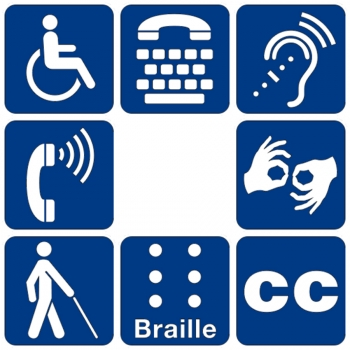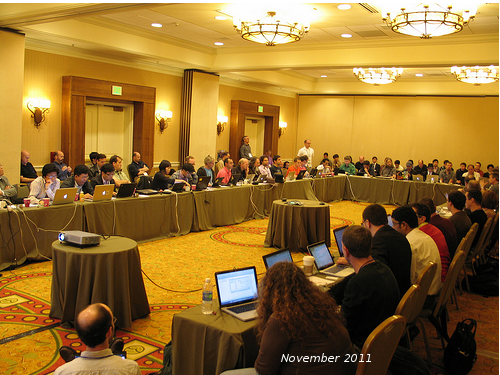Chair Training
Episode I
January 2014
Notice
This training session is audio recorded.
Slides, audio recording, and transcript
will be publicly accessible.
Chair Training Modules
- W3C, Process, and the W3C Team
Philippe Le Hegaret - Tools
Ralph Swick - The Human Dimension
Charles McCathie Nevile - Focusing the Working Group
Arnaud Le Hors
Today's program
- W3C, Consensus, and Group participants
- W3C Team Organization: organizational chart, Director, CEO, and Domain Leads
- W3C Domains
- Technical Report Development Process and Patent Policy
- Advisory Board and Technical Architecture Group
- Role of Team Contact and Chair
W3C, Consensus, and Group participants
W3C
- Develops open standards to ensure the long-term growth of the Web
- Principles: cooperation, adherences to principles, collective empowerment, royalty-free, and voluntary adoption
- Collaboration: Hosts, Team, Members, and Public
W3C
- Follows processes that promote the development of high-quality standards based on consensus
- Processes promote fairness, responsiveness, and progress
- W3C Process set forth the general policies for W3C Groups: participation, appeal, requirements, development, etc.
- W3C Advisory Board manages the evolution of the W3C Process
Consensus
"The W3C process requires Chairs to ensure that groups consider all legitimate views and objections, and endeavor to resolve them, whether these views and objections are expressed by the active participants of the group or by others [...]"
- Consensus: a substantial number of individuals in the set support the decision and nobody registers a Formal Objection
- The Chair may record a decision where there is a Formal Objection and move on
- Formal Objections are reported to the Director, who may send it back to the Group for reconsideration
Group participants
- Groups are composed of:
- Member Representatives
- Invited Experts
- Team representatives
- Must represent at most one organization
- Are subject to W3C royalty-free licensing requirements
Member representatives
- Designated by Advisory Committee representatives
- Are in general employed by the Member organization
- Are under the Conflict of Interest Policy
- May be declined participation by the W3C Director
- Are subject to the royalty-free licensing requirements of their Member organization
Invited Experts
- Invited by the Chair, due to particular expertise
- Need agreement from the Chair and the Team Contact
- May represent an organization (e.g. acting as a liaison)
- Are subject to the Conflict of Interest Policy
- Are required to provide a set of information
Team representatives
- Composed of W3C paid staff, interns, and W3C Fellows
- Are subject to the W3C Team Conflict of Interest Policy
The W3C Team
W3C Team Organization
(Simplified and partial)
W3C Director
- Is the lead technical architect at W3C
- Is responsible for assessing consensus within the community for:
- architectural choices
- publication of technical reports
- creation of new Groups
- Appoints group Chairs
- Resolves appeal of a Working Group decision
W3C CEO
- Leads the W3C organization:
general sounding board for what's going in the Consortium or for getting feedback on your Group - Leads Member relations
- Leads liaisons with other organizations, governments, and the public
Note: Ralph Swick, W3C COO, helps in leading the operations of W3C
W3M
- Is composed of the W3C Management
- Approves new Group charters (after AC review) and extensions on behalf of the Director
- Approves Chairs on behalf of the Director
- Prioritize headlight ideas and resources
Domain Leads
- Lead a set of W3C Groups
- Manage team contacts
- Assist the Director, in particular for assessing consensus, appointing group Chairs, or resolving appeal
Team Contacts
- Act, within the Group, as an interface between the Chair, Group Members, other Working Groups, and the W3C Team
- Assist the Chair in his or her role
- Represent the W3C organization and the W3C Director
see also the role of Team Contacts
MarComm Team
Takes care of Marketing and Communications, including:
- Communications with Membership
- Public relations, including social media
- Website design and content
- Marketing programs in support of business development
- Media and analyst relations
- Publications rules
W3C Domains
W3C currently covers a wide range of issues related to the Web.
- Information and Knowledge
- Interaction
- Technology and Society
- Ubiquitous Web
- Web Accessibility Initiative
Information and Knowledge

Information and Knowledge
Structured information publishing and distribution
- LDP: RESTful application integration patterns using read/write Linked Data
- Data on the Web Practices, CSV on the Web
- Digital Publishing: Publishing on the Open Web Platform
- XML: Query, XSLT, maintenance
- Also looking into linked geospatial data, annotation facilities
Interaction

Interaction
Shape the Web's user interface
- Languages and formats: HTML, CSS, SVG, PNG, MathML, WOFF, Web IDL
- APIs: Sockets, Workers, File, Notification, Timing, DOM, Streams, Storage, XHR, Pointer Lock, Web Driver, …
- Internationalization and multilingual: reviews, ITS, Encoding
- Video & Audio: HTML, Web Audio, MIDI, Media Streaming, Encryption, Media Fragments, Annotations, Captioning, media requirements (with WAI PF)
- Graphics: PNG, SVG, HTML/canvas, 2DContext, CSS
- Styling: a lot of CSS, SVG, WOFF
- Network: XHR, Sockets, Streams, Media Source, Timing, Beacon
- Offline: HTML/appcache, Storage, Indexed DB, Manifest, Service Workers, File
- Device: Pointer Events, Pointer Lock, Input Methods, Screen Orientation, Fullscreen, Gamepad, UI Events
- Performance: Timing, Resource Priority, High Resolution Time, Visibility, Error Logging
- Not yet looking at Gaming
Technology and Society

Technology and Society
Intersection of Web technology and public policy
- Privacy: DNT, reviews
- Security: XML, Crypto API, CORS, CSP
- Patent Policy: PSIG
- Also looking into pervasive monitoring, identity, social
Ubiquitous Web

Ubiquitous Web
Web access for anyone, anywhere, anytime, using any device
- Mobile, televisions
- APIs: WebRTC (P2P connections, P2P Data API, P2P DMTF, RTC Statistics), devices
- Devices: Geolocation, NFC, Media Capture and APIs, Ambient Light, Proximity Sensor, Vibration, and permissions
- Video: Media Capture, Media Capture and Streams, Recording
- System Application: Lifecycle, URI, Scheduler, Contacts, Messaging, Telephony
- Network: P2P connections, Raw Sockets
- Voice and speech: VXML, SRGS, SISR, PLS, SSML, CCXML
- Also looking into automotive, Web of things, payments
Web Accessibility Initiative

Web Accessibility Initiative
Make the Web accessible to people with disabilities
- Requirements, reviews and consultations for W3C specifications
- Recommendations, guidelines, techniques, testing materials
- Guidelines: content (WCAG), user agent (UAAG), authoring tools (ATAG)
- WAI ARIA: Accessible Rich Interactive Applications
- Indie UI: input method independence: events, user context
- Techniques and resources to facilitate website evaluation and repair
- Web symposia on accessibility research and development
- Education and outreach
- Standards harmonization
Horizontal reviews
- Accessibility: Protocol and Format Working Group
- Internationalization: Internationalization Working Group
- Privacy: Privacy Interest Group
- Security: (not assigned yet)
- Mobile: (not assigned yet)
- Javascript APIs: public-script-coord@w3.org
- Web Architecture: Technical Architecture Group
Technical Report Development Process and Patent Policy
How do we make Web Standards?
We get ideas through submissions, headlights, workshops, business groups, and community groups
Only W3C Working Groups produce W3C Recommendations
Standard track: W3C Recommendation Track
…as defined by the W3C Process.
From an idea to a Web standard
Starting points
Submissions, Headlights, Community Groups, Business Groups and Workshops:
These are ways that we get initial input into areas for W3C Standards work and each has its own attributes
Submissions
- Allows W3C Members to propose technology or other ideas
- Published as a Member submission by W3C
- Should not overlap with the scope of a Working Group
Headlights
Propose a topic and develop a plan to address it
- Annual call for proposals in October (e.g. Headlights 2014) to the W3C Members and W3C Team
- Proposals are public
- W3M prioritization of proposals in January
- Approval of projects in July by W3M
Community Groups
- Designed to promote innovation and to lower barriers to individual participation
- Scope may overlap with Working Groups
- Fast and easy to start, open to everyone
- Several CGs have made contributions to Rec Track work and stay open to keep working on additional issues
- Royalty-free licensing obligations are only for the direct contributions
Business Groups
- W3C umbrella for INDUSTRY conversations for things that MAY have Web Technologies as part of the answer
- Fast and easy to start, some fees involved as more staff committed
- Royalty-free licensing obligations are only for the direct contributions
Workshops
- W3C public event to gather the industry to get as broad a view as possible on a topic
- Results of Workshop can vary depending on nature of conversation, participant awareness of W3C and clarity of requirements
Currently upcoming Workshops
- Strengthening the Internet Against Pervasive Monitoring (STRINT)
- Linking Geospatial Data
- Web and TV Convergence
- Web Payments: How do you want to pay?
- New Horizons for the Multilingual Web
See also Workshops
52 Working Groups
Each has:
 One or more Chairs
One or more Chairs- One or more Team Contacts
- A Charter developed with the W3C Members
- Tools:
Mailing list(s), teleconference(s), wiki(s), Version Control System(s), etc.
A Working Group MUST follow the W3C Process.
Group charter
- Proposed to the Advisory Committee and approved by the W3C Director
- Contains the scope, nature of the deliverables, dependencies, communication mechanisms, additional decision procedures, etc.
- Is also a tool for driving the Group, so make it useful and use it well
Groups can proposed to add new deliverables at any time
W3C Recommendation Track
W3C Patent Policy
- facilitate the development of W3C Recommendations by W3C Working Groups;
- address issues related to patents that arise during and after the development of a Recommendation.
W3C Patent Policy
W3C Patent Policy for Chairs
- Patent Policy Management with IPP (eg CSS)
- Exclusion periods are at First Public (150 days) and Last Call (60 days)
- Managing contributions from non-participants: Chair should ask the Contributor to disclose any essential claims and their associated terms
- Exceptions are handled by Patent Advisory Groups (PAG)
Advisory Board and Technical Architecture Group
W3C Advisory Board
- Provides ongoing guidance to the Team on issues of strategy, management, legal matters, process, and conflict resolution
- Manages the evolution of the Process Document, acting as the sponsoring Working Group
- Currently revising the Recommendation Track Process (comments sent to public-w3process@w3.org)
*PROPOSED* Rec Track
W3C Technical Architecture Group
- Scope is limited to technical issues about Web architecture
- Documents and builds consensus around principles of Web architecture
- Resolves issues involving general Web architecture
- Helps coordinate cross-technology architecture developments
Contact the TAG Chairs if you're interested in TAG feedback (Daniel Appelquist, Peter Linss).
Role of Team Contacts and Chairs
Team Contacts (1)
- Is a Participant and Contributor in the Working Group
- ensure coordination and communication; act as an interface between the Chair, Group Members, other Working Groups, and the W3C Team
- are aware of the technical requirements and issues in the Group
- represent the W3C organization and the W3C Director within the Group, i.e. represent the views of the W3C Team even if the Team does not have a single position (note that the Team Contact may raise Formal Objections as well on behalf ot the Director)
Team Contacts (2)
- Drive and help Group organizers in creating charter and convening Group
- monitor group participation and operations: participation, records, publications
- serve as Contact with W3C Team: webmaster, MarComm team, Domain Lead, CEO, Director, etc.
- assist the Chair in completing his or her role, including coordination or moderating disputes
See also Role of the Team Contact
Chairs
- Provides Leadership in the Working Group
- Ensures the Group in making progress and maintaining timelines
- Develop Group charter with the Team Contact and proposes it to the Director
- Coordinate with W3C Team and other W3C Working Groups as needed
- Maintain Group Process & Organization, including maintaining a positive work environment
See also Role of the Group Chair
W3C Director
- Proposes Charters to the Advisory Committee (delegated to W3M)
- Approves Charters and their extensions (delegated to W3M)
- Approves Group closures (delegated to W3M)
- Appoints or reappoints Chairs (delegated to W3M)
- Submit W3C Recommendations to other standards bodies (delegated to W3M)
- Approves First Public Wording Draft publication (delegated to Domain Leaders)
- Approves Candidate Recommendation transitions and beyond (delegated to Ralph Swick and Philippe Le Hegaret)
- Evaluates formal objections (delegated to Ralph Swick and Philippe Le Hegaret)
- Confirms or denies Group decision in case of appeal
- May decline Group participation to an individual
Have an issue?
- Get feedback from your team contact
- If this is not enough, contact the associated Domain Lead
- If this is not enough, contact the CEO and/or the Director
References
Feedback wanted
Help us make Chairs training relevant to you!
- Was this introduction useful?
- What's missing?
- Which part did you learn the most from?
Next sessions
- Tools
Ralph Swick - The Human Dimension
Charles McCathie Nevile - Focusing the Working Group
Arnaud Le Hors